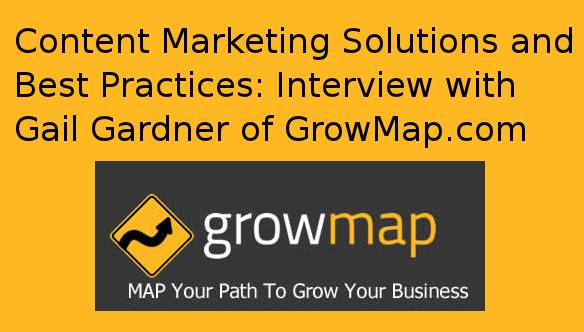
Quality versus Quantity. Focus on reaching the right audience not just getting links. Go Local. These are all concepts that Gail Gardner of GrowMap has been preaching for years. With content marketing taking off in a big way, we asked Gail to elaborate on what she sees as content marketing best practices.
Post Panda and Penguin, content marketing is all the rage, but you’ve been advocating a unique method of content marketng for years. Why?
Early on in AdWords it became obvious that Google was going to make getting traffic – especially to ecommerce and small businesses – more and more difficult.
They could have maximized their own income and made small businesses thrive by allowing them to target unique variations of products and services. Instead, they continually broad match, merging more and more variations of keyword phrases together. They turned search into a zero-sum winner-take-all game. The more first page results they give to big brands, the more serious this becomes for small businesses and the affiliates who promote them.
What does Adwords have to do with content marketing and organic search?
As it becomes harder to buy targeted, converting traffic using AdWords, it becomes more important to get it organically. But with each update starting with Mayday continuing with Panda and multiple Penguins, organic search traffic is also harder to consistently count on. I spell it Mayday because it was an emergency call to action for businesses that lost as much as one-third of their sales. All of these updates show where Google is heading: more traffic for big brands and less for everyone else.
So what is the solution? Why have you been advocating content marketing for so long?
Because content marketing is not only how you get incoming links for better organic positions. If you do it extremely well, you can reach your target audience and build relationships and branding that leads directly to increased sales.
Do you see most writers, agencies and businesses doing content marketing correctly now?
No. Most still have a “build links” mindset that has them guest posting for quantity instead of wisely crafting their message and delivering it to where their potential buyers already are.
Great content marketing is about:
- Your message
- Reaching those interested in what you offer
- Building your brand and relationships
- And only lastly about links
Don’t we need to get large quantities of content out there and plenty of links? That is what clients doing blog outreach want.
I agree it is what they think they need, and what many of them still want today. It is up to us to get them to understand what really works. As I quoted Hubspot as saying in a post on How to Increase Conversions By Sharing Pillar Content When Your Audience is Most Receptive:
“Do NOT dilute your high-quality content with mediocre or low-quality content!”
So how do you choose sites? How do we find the best places to publish content?
This is not as difficult as many assume. A business usually already knows what the most relevant sites are in their industry. Relevance is Key. You want to have content published about you on the sites most closely related to what you offer. They can deliver the most targeted potential buyers.
And if you don’t know enough relevant sites? Besides using a search engine how else can we find them?
Fortunately for us, over the years many tools have been developed that have improved over time. For large agencies and brands, GroupHigh has a database of over 13 million blogs that is searchable by keyword. Their system pulls relevant stats and ranks sites by influence. GroupHigh is only for large agencies and brands though as the subscription price is substantial.
InkyBee is a newer similar service that has over half a million blogs in their system today and that number is growing fast because of the way it researches. Their co-founder Hugh Anderson tells me they are positioning themselves as ideal for smaller, independent agencies and focusing on campaign measurement. They are working on more sophisticated relationship mapping.
BlogDash encourages bloggers to volunteer if they’re PR friendly to deliver an increase in positive outcomes to blog outreach managers. Users create an opportunity, choose bloggers to share it with, and can offer either paid or free opportunities. They can also offer other incentives. Writers can sell their content using BlogDash.
PostJoint enables content producers to submit their content. They then receive five offers from publishers. The content owner chooses which site they want to publish that specific piece of content. Both free and paid offers are available. The content producer determines what types of offers they receive when they submit their content. PostJoint had paid out over $100,000 in April and is already at $143k this month.
MyBlogGuest is the oldest blogger outreach community. Content is submitted and bloggers offer to publish it. They strictly limit links to one *self-serving* link per post and all content is offered at no cost. They have a new infographics gallery promotion section I am currently testing.
GuestBlogIt and the brand new Guest Crew are blogging communities similar to MyBlogGuest. They have less to offer at this time, but could bloom later.
How can an agency or business know which of these will work best for them?
I am currently working on a case study comparing results from several of these blog outreach platforms. Only by using them all is it possible to advise others on which will work best for them. I’ll know much more very soon and your readers are welcome to contact me. Skype works best and other methods can be found on the contact tab at GrowMap.com.
What about the controversy over earned versus paid media? PR agencies believe bloggers should publish for free, but bloggers have to make a living somehow, right?
As you can see from the various formats the blog outreach platforms I’ve mentioned use, there is not yet any consensus regarding whether content creators or content publishers should bear the cost. The bottom line is that most content gets created because someone pays. Whether that should be the business, or the writer, or the publisher remains to be worked out.
What other controversies are there about content marketing and blog outreach?
Links – how many and where to put them – are definitely the #1 largest challenge. The days of sourcing content and sticking your link at the end or in the bio need to be over. Whatever links you need should be an integral part of the content you write or have written for you.
I would much rather have a post about how what you offer benefits my readers or how your company used Internet marketing or social media to drive sales or generate leads than yet another generic post. Both offer you the opportunity to get the links you need to balance your link profile.
The standard that has emerged is to permit one link that benefits the writer or their client and up to three other links to what are referred to as “authority” sites. I encourage publishers to permit relevant links to quality sites whether or not they are the large “authority” sites most think of such as Mashable, Techcrunch, or Huffington Post. Because the content on those largest sites varies in quality, many small sites have content as good or better.
This latest Penguin has caused many to be afraid to link out. Bill Hartzer wrote In a Post Google Penguin World, It is Still Okay to Link Out:
“Here in June of 2013, I am horrified that I actually have to have this conversation with other website owners and bloggers. I mean, really. Why would it possibly hurt your search engine rankings if you linked out to a company’s website when you mention them in your blog post?”
Unfortunately, sites that have been penalized by Google are often much more reluctant to allow links to businesses. Their fear is that Google may assume the links are paid – even if they aren’t – because businesses might be willing to pay for links in a post-Penguin world.
I encourage everyone to do what is right and stop worrying so much about Google. You can’t keep them from moving your cheese or slapping your site. Many become collateral damage. So focus on reaching your target audience and giving them what they want.
Let’s summarize the key points we’ve discussed. What do people most need to focus on to do content marketing effectively?
All blog outreach comes down to one thing: relationships. Build relationships with bloggers in your areas of interest and future blog outreach projects become much easier. And remember these points:
- Quality, relevant content is more important than quantity.
- Think local whenever you can. Encourage blogs to add local content and their location to their sites.
- Use persuasion to overcome link reluctance we’re seeing thanks to Penguin.
- Audience, audience, audience! All your content should be crafted to reach potential buyers and NOT just to get another incoming link.
Thank you so much for your time, Gail. These insights and the blog outreach platforms you’ve shared will benefit both those new to content marketing and experts as well.
Always happy to share, Murray. Thank you for asking me. I do hope your readers will focus on relevance and quality over quantity. They can read my post mentioned previously to find out more or contact me directly through the methods on the contact tab of GrowMap.com.




